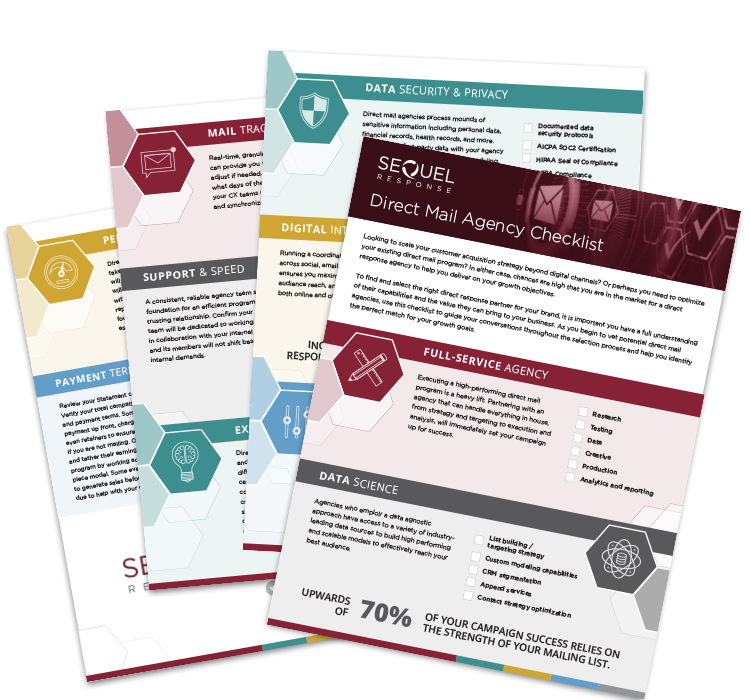Direct Mail: Lower Cost vs. Lower Cost Per Acquisition

Brands new to direct mail may experience sticker shock when they start collecting proposals to determine if a targeted mail program is right for their customer acquisition strategy. As they compare direct mail costs and options, some may even fall victim to thinking the lowest priced campaign will generate the lowest Cost Per Acquisition (CPA). In fact, the “low-cost equals low CPA” misconception is common at every stage of the direct mail process.
CPA is a metric used by marketers to determine the cost of acquiring a new customer – calculated by dividing the total campaign cost by the number of sales. In other words, 50% of the CPA result is reliant on how many sales can be generated.
In a direct mail campaign, a multi-component oversized letter package with high end data will generate more sales than a 4×6 postcard with a few demographic selects. The real question is, “how many more sales?”
This article will examine low-cost options for direct mail data, creative formats, and postage to demonstrate how paying a premium for these essential components can actually lower your CPA.
Shared Mail vs. Solo Mail
Those looking to dip their toes into direct mail often start with shared mail. Aside from both mail types arriving in mailboxes, shared mail and solo mail could not be more different.
The average shared mail piece is three cents. The cost per piece is low because your brand is sharing an envelope with more than a dozen other brands and offers. In a communal advertisement such as this, the odds of getting lost in the crowd are high. Targeting options are also limited, therefore you are not mailing to your best prospects. Instead, you may be wasting limited budget mailing to a pool of “maybes” who will limit your response rate.
Solo mail is a more expensive form of direct mail, as the cost per piece is at least 10x that of shared mail. However, your brand and offer are the only one in that package. Another key differentiator is solo mail offers the ability to target your ideal prospects based on individual consumer insights and data, making your odds of conversion 10x higher. This case study explains how a brand’s jump from shared to solo mail produced a higher conversion/sales rate and a lower CPA.
Format
A 4”x 6” postcard is the most affordable solo direct mail format to produce. New mailers often default to this format because it is the lowest cost of entry into the channel. Due to its small size, you only have 24 square inches of real estate, and eight of those inches are dedicated to the address block. It can be tricky to tell your brand’s story in such a tight space. Additionally, the small size increases the chance of your piece getting lost in the mail stack.
Oversized postcards, such as 6”x9” or 6”x11”, cost slightly more to produce, yet offer 3x the space for your messaging. Oversized self-mailers and letter packages create the largest presence in the mailbox and are more expensive to produce.
Now let’s do the math. Production related line items claim around 20% of the entire mailing cost. That means if a letter is 50% more expensive than a 4”x6” postcard to produce, the letter only needs to generate a 10% lift in sales for it to be a CPA winner.
The advice here is not to avoid classic postcards and always go for a letter package. Rather, when building your mail program, resist the urge to just choose the cheapest format to save on direct mail costs. Instead, match the format that will fit best with your brand and your audience, and the CPA will naturally follow suit. This case study shows how regular creative testing will ensure your format consistently engages your audience.
Data
With so many direct mail data options available to create your mailing list, new mailers (and even seasoned mailers) may struggle when developing a list strategy. You can rent consumer data from affinity lists (donors, subscribers, purchasers), hotline/trigger files (new movers, new parents, etc.), massive, compiled databases (with consumer geo/demo-graphic and lifestyle/interest information), and even niche cooperative databases. List pricing varies based on source, level of customization, and more.
Just like production, data is another substantial line item in your budget. A straight list select, i.e., choosing one list with no customization or data modeling, may cost only a few cents per record. A look-a-like model – a customized list built from your ideal customer profile – is priced around 10 cents per record. Those watching direct mail costs closely often choose the least expensive option thinking they can mail more records or spend more on another campaign component. Yet, when you consider data is responsible for up to 80% of your response rate, this could be a costly mistake.
Look-a-like models are built off thousands of variables, not just one list. Building a mailing list from multiple data sources, numerous data sets, and several models will allow you to mail to the prospects with the highest propensity to buy your product. This case study confirms spending more on the right data source is critical to hitting your sales and CPA targets.
Postage
Over 50% of your direct mail costs are allocated directly to the USPS for postage, making this an appealing place to start searching for discounts. The USPS offers a variety of promotions and postage discounts to help offset this expense. Here’s how each can affect your campaign costs.
USPS Promotions & Incentives
Each year the USPS presents mailing promotions that rebate 2% to 4% of your postage bill. Most of them will indeed save your money, such as the Informed Delivery incentive, while others may end up costing you more. For example, to qualify for the sensory promotion, your mailer needs to include an element like soft touch, UV coating, or embossment. While adding these items to your piece will qualify for a discount, you will spend more on production than you will save in postage. However, since this article is about CPA rather than overall cost, we must mention this type of design innovation can positively increase your sales rate enough to be a CPA winner!
First Class vs. Standard Mail
First Class mail is delivered twice as fast as Standard Mail but carries a premium cost. First time mailers may not even know they can choose a mail type other than First Class. Brands that mail based on event triggers (new mover, birthday, new child, etc.), should use First Class. In nearly all other circumstances, we recommend leveraging Standard Mail’s affordable postage rate.
Every Door Direct Mail
Every Door Direct Mail (EDDM) and high-density carrier routes are a great way to lower your postage costs. However, if you are not a high-volume mailer, qualifying for these postage tiers could mean sacrificing your data targeting strategy to send to a whole neighborhood. Because data has a substantial impact on campaign success, this is often not worth the discount when viewed on a CPA level.
________
Despite what your inner Scrooge may suggest, the truism “you get what you pay for” certainly applies in direct mail strategy. Spending a premium on your direct mail channel, creative format, data strategy, and postage price may lead to a bigger investment up front, but can ultimately lower your cost per acquisition in the end. Talk to a marketing strategist to learn how to lower your direct mail costs today, or check out this infographic for 6 Common Direct Mail KPIs and how to calculate them.
Featured on BRAND United on 6.7.22

